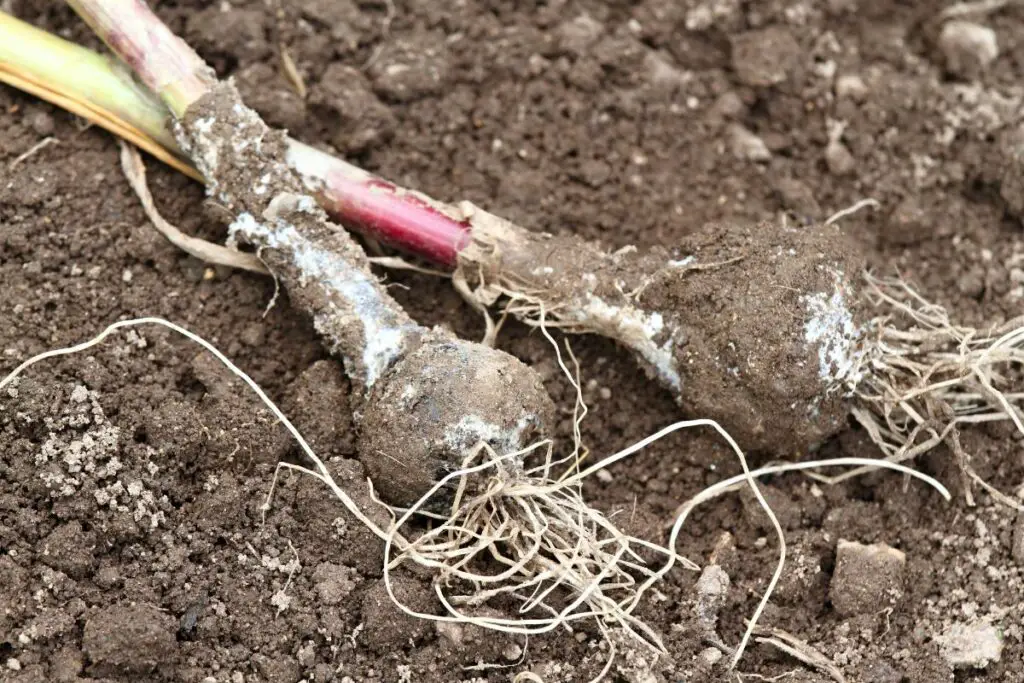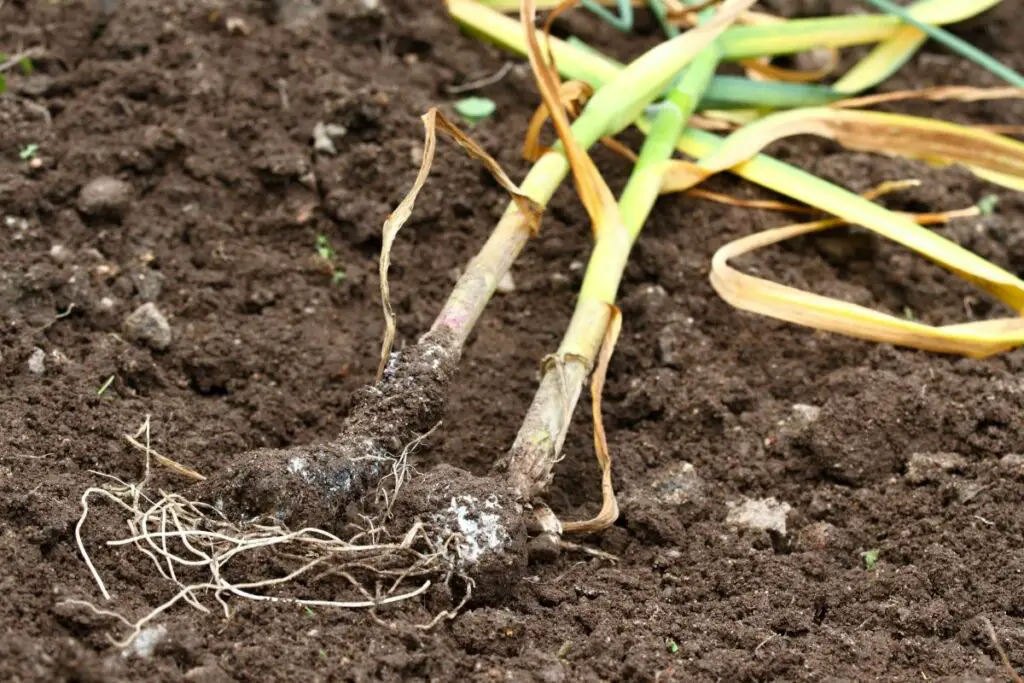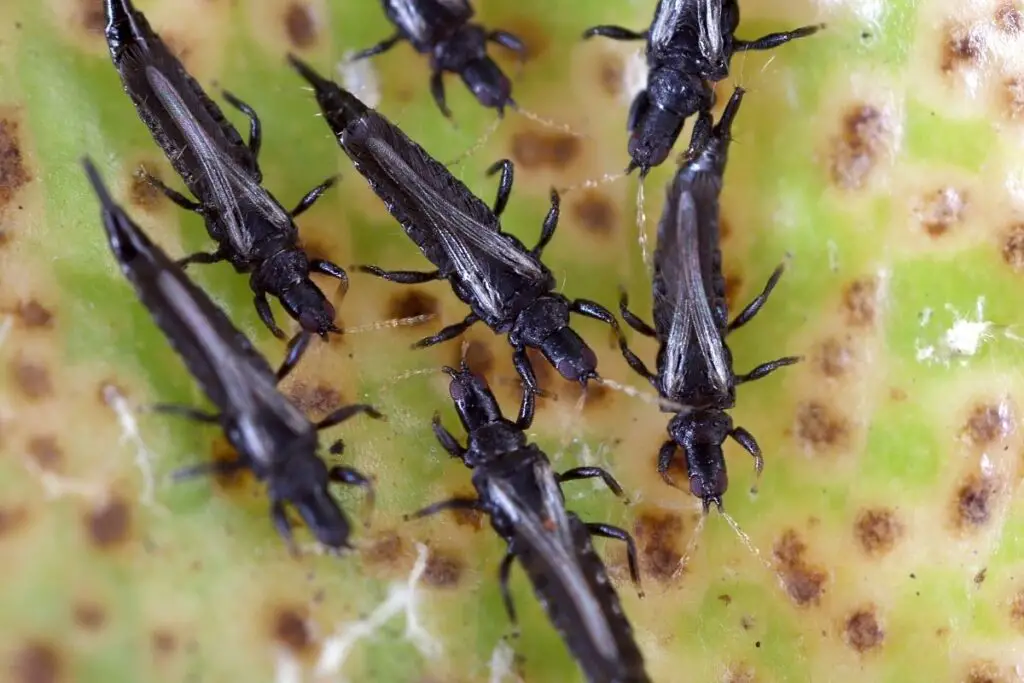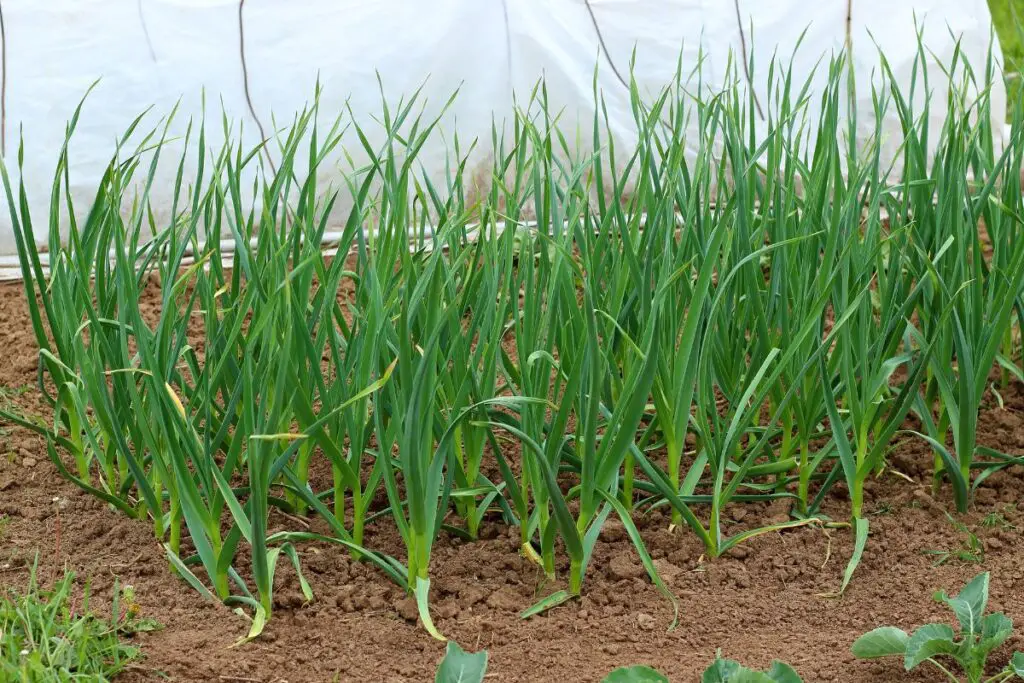There is nothing more satisfying than growing garlic in your garden. But, it can face certain issues like rotting. Today, we will explore the reasons behind garlic rotting.
Garlic rots due to high soil acidity, airtight crust, or lack of nitrogen. It also rots due to diseases like fusarium, gray rot, white rot, black mold, and pests like onion moths, flies, and nematodes. Identifying the underlying problem and using preventive measures can save the plant from dying.
I will share the possible reasons behind garlic rotting and how to deal with the problems in this article. So, keep reading.

Non-contagious reasons behind rotten garlic bulbs
There are various reasons behind garlic rotting, both contagious and non-contagious.
Here are some non-contagious reasons:
- Excessive high acid levels can rot the garlic bulbs in the ground. Garlic prefers a pH level between 6 and 7, but improper pH levels can result in basal rot.
- The underground water will rise once the soil defrosts and the snow melts. This water will flow up near the bulbs. If you water the garlic plants in winter, excess water will accumulate around the bulbs and rot them.
- Airtight soil blocks the oxygen from entering the soil and reaching the bulb roots, thus causing the garlic heads to rot. Garlic plants will enjoy staying in well-drained, fertile, and loose soil. Planting spoiled cloves without checking will give you rotten bulbs. Check the cloves before planting.
- Lack of nitrogen can also result in rotten bulbs. The lack of nitrogen doesn’t allow the cloves to form a root system. So, if only the cloves stay under the ground for a long time without any root growth, they will rot. Fertilize them with a fertilizer having nitrogen. If you are applying nutrients separately, don’t forget nitrogen.
- Sometimes, the winter garlic will rot in the spring due to frost damage. If the cloves are not planted at the right depth or not covered well, the cloves will freeze and begin to rot when they receive the spring warmth. Plant the cloves 2-4 inches deep and cover them with straw or leaves.
Garlic rotting due to mechanical damage
Sometimes garlic rot due to physical damage, wrong planting, or carelessness.
Below are some situations which can rot the garlic bulbs:
- Garlic will rot if you use the wrong equipment for planting or harvesting. Some gardeners use garlic poppers or undercutters to harvest. These can hurt the bulbs and make them rot in the ground or during storage.
- If the stems of the garlic plants are leggy, they can affect the bulbs because water and nutrients fail to reach them, thus rotting them.
- Handling the bulbs without care can hurt them and lead them to rot. You must be careful while handling the bulbs. Consider checking your bulbs once daily to see how they are doing.
While harvesting, be gentle and slow. Use a fork and gently pull the plant when you see the bulbs.
It can help you spot any issues and treat them immediately so that it doesn’t spread much and end up killing all your crops.
Why does garlic rot after harvest?
Sometimes garlic will remain fine in the ground but will begin to rot after harvest.
It is because you don’t cure them well before storage.
The bulbs are not dried enough.
Garlic bulbs under the ground have moist outer covers.
Let the outer cover dry until the top later looks like paper.
Garlic bulbs can also rot if you don’t store them properly.
For example, storing them in airtight boxes can rot the bulbs due to a lack of airflow and oxygen.
Store them in a well-ventilated box.
Diseases rotting the garlic bulbs

Some common diseases that can rot the garlic bulbs are:
- Fusarium or Root rot
- Sclerotinosis or White rot
- Aspergillosis or Black mold
- Gray rot or Botrytis
- Bacteriosis
It is always the fungi, in most cases, for which the garlic bulbs begin to rot. Bacteria attack the mature stored bulbs.
Garlic rarely rots in the ground due to bacteria.
Let’s talk about the diseases and how they rot the garlic bulbs.
Also read: Problems With Garlic Plants (Yellow, Brown, Drooping, Bugs, & More)
Looking for gardening supplies? We have tested 100's of products before recommending them to you guys. Check out our best pick below:
| Image | Gardening Supplies | Best Price? |
|---|---|---|
 Top
Top Top
Top | Raised Garden Bed Kit | Check On Amazon |
 | XLUX Soil Moisture Meter, Plant Water Monitor, Soil Hygrometer Sensor for Gardening, Farming, Indoor and Outdoor Plants, No Batteries Required | No Results |
 Top
Top Top
Top | 82 Pcs Garden Tools Set and Extra Succulent Tools Set | Check On Amazon |
 | Joeys Garden Expandable Garden Hose with 8 Function Hose Nozzle, Lightweight Anti-Kink Flexible Garden Hoses, Extra Strength Fabric with Double Latex Core, (50 FT, Black) | No Results |
 Top
Top Top
Top | Dual Chamber Compost Tumbler | Check On Amazon |
 Top
Top Top
Top | Sunnyglade Plant Stakes | Check On Amazon |
 Top
Top Top
Top | Organic Cold Pressed Neem Seed Oil | Check On Amazon |
 Top
Top Top
Top | Mighty Mint Gallon :-Insect and Pest Control Peppermint Oil | Check On Amazon |
 Top
Top Top
Top | Scotts DiseaseEx Lawn Fungicide | Check On Amazon |
 Top
Top Top
Top | Jacks Classic 20-20-20 All Purpose Fertilizer | Check On Amazon |
 Top
Top Top
Top | 30,000 Seeds Pollinator Attracting Wildflower Mixture | Check On Amazon |
 Top
Top Top
Top | Survival Vegetable Seeds Garden Kit-Over 16,000 Seeds | Check On Amazon |
Fusarium rot or root rot
Also called bottom rot, Fusarium rot is difficult to identify first because the bulb starts rotting at the roots.
Slowly, the infection spreads to the bulbs, their bases and bottoms turning light pink or yellow.
The teeth dry out and wither.
The leaves turn yellow and have some brown stripes when the root dies.
The main cause of this root rot is overwatering along with high and humid temperatures above 55-60°F.
Such conditions are perfect for microorganism reproduction.
Even the healthy bulbs will begin rotting when stored with the diseased bulbs.
How to fix the problem?
The best way to fix Fusarium rot is to dig up the bulbs and destroy the rotten bulbs and infected plants.
Consider crop rotation so that the good ones don’t get infected.
If you notice the infection during storage, immediately discard the affected bulbs.
You can prevent the disease by watering the plant well without creating any pool and by improving air circulation around the plants so that humidity stays under control.
Sclerotinosis or White rot
This disease occurs in the soil in the growing season.
The infection can also appear during storage time.
The fungus of White rot can move from an infected bulb to a healthy one.
The initial sign of an infestation is upper leaves turning yellow that ultimately die when the disease progresses.
The bulb also starts rotting, the lobules become watery, and the roots have white mycelium.
Reasons for this disease development are low temperatures not more than 68°F accompanied by high humidity above 60%.
Such conditions make garlic bulbs rot, especially those planted in the fall.
How to control the disease?
- MAXIMIZE YIELDS
- ZERO POLLUTANTS
- KILLS AND PREVENTS POWDERY MILDEW AND OTHER INFECTION
- RECOMMENDED BY CULTIVAT
You can control White rot in three ways – chemical, organic, and thermal.
For treating the disease with chemical fungicides, it is essential to know the dosage and method of application.
It depends on the brand and the instructions given on the labels.
Seeds are dipped in fungicide before planting.
Apply fungicide during the growing seasons when you see the signs of infection.
In the organic method, you can destroy the white mycelium even before you can spot them, that is, before planting the cloves.
You can soak the cloves in hot water heated at 115°f before planting for 30 minutes.
You can use Diallyl Disulfide in the soil where you will plant the garlic cloves.
This product is a fungus stimulator that encourages mold growth.
But since the owner is unavailable, the fungus will die.
Apply it when the soil temperature is around 48°F, and the air temperature is around 80°F.
For thermal treatment, you need to raise the soil temperature to a level where the fungi will die.
If you plant garlic before winter, then fry the selected area in the summer. It works well in the hotter climate.
Cover the area with a black film and store it for 1½ months.
Aspergillosis or Black mold
The heads of ripe garlic will rot when in storage.
First, only one clove gets affected, and slowly, the entire bulb gets affected by the disease.
Even good bulbs that come in contact with the diseased bulb can get mold.
The lobules become soft, and only black color remains in the husk.
It happens when you don’t cure and dry the bulbs before storage or when they remain wet in the ground.
The disease can also affect the teeth from inside the bulbs.
How to treat the disease?
Since the disease occurs mostly during storage, you cannot treat the disease.
To get rid of it, you need to examine the garlic heads and dispose of the damaged ones to prevent the infection from spreading to the good ones.
Gray rot or Botrytis
Gray rot of Botrytis blight is caused by a species called Botrytis allii.
The disease affects the collar at the ground level.
The symptoms are seen in spring or early summer.
The appearance is like a watery lesion over the stem.
Over time, the fungus begins to spread in the bulbs, leaving the outer wall of the stem unaffected.
Since the effect is inside, the signs remain unnoticed until displayed outside.
When you see the signs outside, the damage is already done.
The outer husk in the mature head of a diseased plant becomes deep purple.
Over time, the color changes to brown or black.
The infection attacks the plant when the air is cool, but the soil is moist, especially during the spring or early summer.
But if the temperature rises above 70-80°F, the fungus will stop developing further.
How do you get rid of the disease?
You need to remove the damaged plant and bulbs to eliminate this infection.
Remove the stalks during harvest and then spread the bulbs over a tray in a single layer to find out the defective bulb and discard it.
Increase the air circulation, and don’t forget to dry the bulbs well before storing them.
Bacteriosis
Bacteria generally attack the matured bulbs at the time of storage.
The separated cloves start rotting.
The bulbs will have some brown spots outside.
But when you cut the cloves, you will find that the inside has completely rotted.
In severe conditions, the bacteria will eat the soft tissues of the cloves under the hard skin.
The pulp of the cloves becomes watery and glassy.
The reason for this infection is insufficient drying of the bulbs before storage.
High temperature and humidity lead to the spreading of the bacteria.
How to get rid of it?
Inspect the seeds and the cloves at the time of planting and the bulbs during the growing season.
Spray with a 1% solution of Bordeaux in the growing months.
The last treatment should be done 20 days before the harvest.
During harvest, find the diseased heads, if any, and throw them away.
Garlic bulbs rotting due to pest infestation

Only diseases and other non-contagious problems are not the only ones to be held responsible for rotten bulbs.
Pests can also rot the bulbs.
However, rotting doesn’t happen without bacteria and fungi.
The microorganisms enter a damaged plant through the wounds caused by the pests and then rot them.
The main bugs are:
- Onion flies
- Onion butterflies or moths
- Stem or bloat nematodes
- Bear and beetle larvae
- Thrips
Onion worms, bear, and beetle larvae attack mostly the roots as they stay underground.
So, these bugs are more difficult to remove.
Let’s see how these bugs can rot the bulbs and what we can do about it.
Onion flies
It is the larvae of the flies that cause the damage.
The female onion flies lay eggs under the clumps of soil close to the plant.
The larvae make holes at the bottom of the garlic head.
They feed on the pulp of the garlic, and the bacteria then sits on the damaged garlic and starts rotting them.
You can identify the attack by noticing the eggs easily visible at the base of the socket.
But, the notice is usually seen when the garlic has rotten already.
How to remove onion flies?
The best way to control the infestation is by using insecticides.
One good product is Aktara.
Except for this, you can do the following things:
- Spread wormwood over the soil bed
- Planting carrots with garlic
Change wormwood when it fades.
As it is a wild weed, you cannot keep wormwood planted in the garden.
You can plant carrots, but they should not be garlic’s companion.
It would help if you kept the garlic bed dry before planting, but you can’t keep the carrots dehydrated.
The latter needs frequent watering.
Plant carrot and garlic in stripes so you can water carrots without touching the garlic.
Onion butterfly
This moth attacks the allium family in the middle of spring and ends its activity during the early fall.
It lays eggs at the bulbs’ base and under the leaves and peduncles.
The larvae damage the inflorescence, stems, and the new, unopened leaves.
Due to the activity of the bugs, the bulbs fail to get sufficient nutrients for which they stop growing and start rotting.
One evident sign of onion moth infestation is wilted and distorted leaves and the death of the lower plant part above the ground.
How to get rid of onion moths?
For chemical treatment, you can try the same insecticide used for flies.
To reduce the moth population in the agrotechnical method, try the following methods:
- Deep plow after harvest
- Consider crop rotation and return to the same place after 3-6 years.
- Remove the dry tops after harvest.
- Maintain proper air circulation in the surroundings as well as in the soil.
Another method is to cover the garlic overnight with non-woven material and remove it in the afternoon.
Stem nematode
These bugs enter the leaves and plants through the wounds and feed on the tissues.
It damages the stems, leaves, and bulbs.
The cloves become soft and begin to rot.
The larvae stay in the garlic seeds.
The signs of damage are yellow leaves, deformed bulbs, and plant death.
How to control stem nematodes?
To prevent the infestation, add per calcite ameliorant, urea, and ammonia water to the soil before planting the cloves.
Consider checking the temperature around garlic before and during storage.
It should be around 30-50°F with an average humidity level.
Consider crop rotation.
Bear and beetle
These bugs stay underground and damage the roots and the bulbs.
The garlic heads will start rotting.
The female bear gnaws on the plant parts under the ground while digging the underground passages.
The beetles feed on the roots.
During the damage, the putrefactive bacteria enter.
How do we fight bears and beetles?
It is useless to use insecticides in the case of beetles because their larvae stay deeply underground.
Grizzly and Bear Drops can be used to deter bears.
These insecticides are specifically made for bear destruction.
You can also apply tobacco dust or ash after watering to spread them over the soil.
Adding these substances can also kill some underground pests.
Make sure the soil is loose and well-aerated and not compact and airtight.
Thrips
Thrips pierce the leaves, feed on the plant sap, and damage the garlic growth.
It can further stunt garlic growth and rot the bulbs.
Besides, the piercing can be an open path for the entrance of various pathogens and bacteria, which can play a major role in rotting the bulbs.
How to get rid of thrips?
Since thrips can fly, you can use sticky traps to trap the thrips in the sticky cards.
Since thrips like hot and dry weather, use it as an advantage and keep the soil consistently moist.
Release natural predators like ladybugs, lacewings, small pirate bugs, and parasitic wasps.
Use insecticidal soaps like bonide, neem oil, and spinosad.
Consider crop rotation to prevent weeds. Weeds can also attract thrips.
Plant companions with a strong smell like dill, coriander, dandelions, and fennel.
Other ways to destroy the rotting
Soak the seeds in 1% of potassium permanganate solution or furacilin.
Infuse poisonous herbs like calendula or yarrow.
Cut 50g of green mass, add it to one liter of water and soak them for a week.
Strain and pour the water into a 10-liter bucket and water the beds with it before planting.
If necessary, you can repeat the process during the growing season.
How can I prevent garlic from rotting?

- Select healthy cloves and seeds before planting.
- Warm the planting beds before winter planting.
- Give them enough nitrogen.
- Loosen the soil before planting and make the planting bed weed-free.
- Harvest the garlic when the lower leaves have yellowed and dried.
- Let the bulbs dry well before storage.
Final thoughts
Garlic can rot for various reasons, like wrong pH levels, rising underwater, spoiled cloves, airtight soil, pests, diseases, and mechanical damage.
Check the cloves before planting and remove the damaged bulbs during storage. Take immediate steps if you ever find any infestation.
Be careful while handling the bulbs and maintain basic tips for soil, watering, sunlight, fertilizing, and proper planting.
Also read: Why Is My Garlic Plant Dying? (Causes+How To Fix)
Reference: The Pennsylvania State University, Garlic Production for the Gardener, University of Massachusetts Amherst, Ohio State University Extension.

